Les Gets, France – With four ski trips to the Alps under my belt over the past ten years, all of them to the Tirol region in western Austria, I steeled my resolve last October to expand my horizons and book a long deferred inaugural visit to the French Alps. That decision turned out to be the easy part; more difficult was choosing a specific destination amongst France’s 20 interconnected ski regions – the majority of which have a mind-blowing amount of terrain, impressive vertical drops, atmospheric villages, and top-shelf on-mountain cuisine. While weighing the pros and cons of each option, it quickly become obvious that the only thing more frustrating than not having enough choices was having too many.
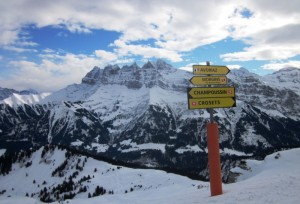
To narrow down my list of candidates, I first addressed one of the main reasons that many North Americans don’t fly across the pond for their destination-trip fix: a seven-hour flight followed by a multi-hour ground transfer to the resort, resulting in — at the very least — a lost ski day on the way over. To address that, there’s an easy remedy: fly into Geneva, from which four major ski regions are no more than a 75-minute drive away. Since there are nonstop flights to Geneva from Newark, JFK, and Dulles that all land first thing in the morning, it’s possible (depending on how well you deal with jet lag) to get in at least four hours of arrival-day turns.
With that issue out of the way, I decided to go big and visit the largest ski region near Geneva: the Portes du Soleil, which one can liberally translate as “The Gateways to the Sun”. It’s a sprawling circuit comprising more than 250 miles of marked trails on both sides of the France/Switzerland border, along with thousands of acres of off-piste that can be traveled in either direction. It’s so big that North Americans, accustomed to repeatedly lapping favorite terrain pods at our unconnected (and thus far smaller) resorts, may find it tempting to spend the entire week racking up miles skiing from one village to the next across the region’s 12 sectors, just for the novelty of it all.
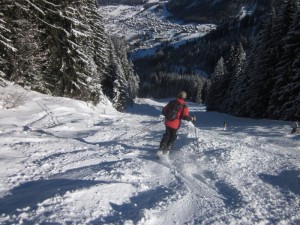
The Portes du Soleil has the paradox of being at a low general elevation compared to many of France’s most popular ski regions (top elevation: 8,000 feet, low elevation 2,700 feet) with a heightened chance of rain and variable conditions toward the bottom of the mountain. At the same time, it sits in an advantageous microclimate along the Alps’ northern boundary between Lake Geneva and Mont Blanc, where moisture-laden winds coming in from the northwest drop lots of snow.
Les Gets and Morzine
Following a 55-minute shuttle from the airport, we pulled into my headquarters for the next three days: the picturesque chalet village of Les Gets (pronounced “LAY-SHJAY”). After dropping off my bags and grabbing an extensive breakfast at the charming ski-in/almost ski-out Hôtel Alpina, my accommodations for the next three days, I still managed to board the resort’s Chavannes gondola by 10:30 a.m.
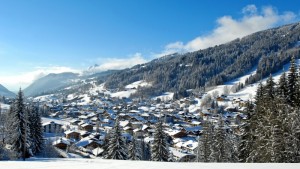
With more than 50 lifts draped across several distinct sectors, Les Gets and neighboring Morzine feature a wide variety of groomed trails that roll and zigzag through the dense woods. Even though they’re known primarily as an intermediate’s paradise, the off-piste terrain was more interesting than the resort’s reputation led me to expect. Moreover, the tree-lined slopes serve as a great bail-out option on windy storm days with low visibility. Finally, since a large percentage of this low-elevation terrain is covered by grass-covered meadows with very few rocks, it’s skiable without a significant amount of snow. I was also intrigued by how you ski right through Les Gets’ all-organic golf course – the first in France to be awarded the prestigious ISO 14001 environmental certification.
By early afternoon, I headed toward above-treeline Chamoissière, which has the best snow and most challenging terrain of the Morzine sector. Roughly 2,700 vertical feet later at the summit, I got my first a taste of the immense scale of the Portes du Soleil and realized that the trail map doesn’t come close to conveying the ski region’s size.
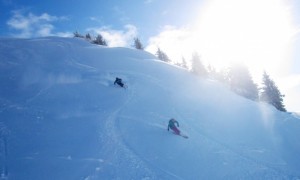
While enjoying delicious, well-presented dinners at Hotel Alpina’s atmospheric dining room, I met people from all over Europe. Many were repeat customers who all gave Les Gets excellent grades for its family friendly offerings: an elaborate snow park for kids, a lively, relaxed downtown area, skating, swimming, as well as the highly regarded Museum of Mechanical Music.
The only downside to Les Gets is its location at the far southeastern end of the region. That means that you’re about 45 ski minutes away from the higher and more snow-sure terrain of Avoriaz. For those who’d like to be closer to the Portes du Soleil main circuit, Morzine — the largest and most animated town in the region — makes more sense. With piles of restaurants, bars, and lodging options contained within a cute traditional mountain village, it’s an easy choice for destination visitors. In addition to the convenience factor, there are all sorts of non-ski activities, including cheese dairy visits, on-snow Segway tours, and skiing with a white-tailed eagle, all of which I would have tried if I’d had more time.
The one non-skiing activity at Morzine that I couldn’t pass up (and can recommend without reservation) is la luge nocturne, i.e. night sledding or as the many Brits here would call it, “sledging.” Literally ten steps from my accommodations at the Hotel Équipe, about 50 of us clicked out of our skis at dusk and rode the Pleney gondola to mid-mountain. After breaking the groups into French- and English-speakers, everyone was given headlamps and a quick tutorial on how to operate the sleds, some safety procedures, and a couple of minutes later, we were on our way.
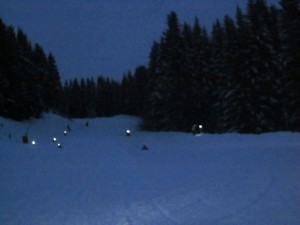
Even though the terrain was at steepest a mild blue, the sleds quickly gained speed and everyone realized in short order that it took a bit of trial and error to learn how to steer the sleds. Strongly pulling one brake without feathering the other often resulted in a high-speed end-over, followed by an entertaining pile up with anyone following directly behind.
After about 45 minutes we arrived at the bottom of the mountain and dove into a big outdoor après-ski party already in full swing. There, I ran into the one American in our group and we laughed about how U.S. ski areas’ legal teams would be all over night-sledding in a split second and demand that participants sign a multi-page denial of liability.
Mont Chèry
While the Portes du Soleil’s prime attraction is the sheer amount of interconnected lift-served terrain, it also features three free-standing ski areas just outside the region’s perimeter that are perfect for avoiding crowds on peak days. One of these, Mont Chéry, is only a five-minute walk from the main street of Les Gets or a quick ride on the cute (and free) Petit Train. The minor “inconvenience” of its separation from the rest of the circuit keeps crowds to a minimum, creating a quiet haven for locals and a quasi-private ski area vibe.
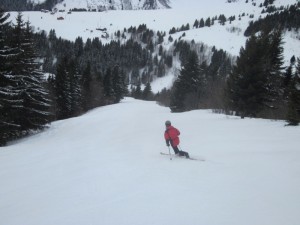
Equally important, Mont Chéry offers a consistent 2,000-foot vertical drop, some challenging black terrain, and great views of Les Gets’ wooded slopes across the valley along with the majestic Mont Blanc in the distance. I spent most of the morning doing laps on the mountain’s deserted north face, where the snow was beautifully soft, chalky, and only intermittently tracked, a huge difference from the crunchy slopes on the other side of the village that day.
Avoriaz and the Swiss Sectors
A majority of the resorts in the Portes du Soleil grew out of long-established villages in the valley. Avoriaz, on the other hand, was purpose-built during the late 1960s to take advantage of the highest elevation in the region, an incredible setting on a massive stone shelf that reportedly receives the most snowfall of any major resort in France. From a skiing perspective, it’s unquestionably the best location in the Portes du Soleil with a wide array of terrain and easy access to all of the Swiss sectors. It’s also 100% car free; you either use a hand-pulled sled to move your things around or hire a horse-drawn sleigh, which seem to be everywhere.
A unique feature of Avoriaz is a natural terrain park in the Lindarets Valley called “The Stash,” designed by Vermont’s snowboard pioneer Jake Burton. Winding more than 1,500 vertical feet through a pine forest, The Stash offers all sorts of features created out of natural materials, including logs and tree trunks, tables, wooden slides and ramps, as well as all signage and decoration. Even a confirmed park avoider like me lapped the all-mountain/freestyle hybrid four times and kept discovering new things on each descent. I also liked the subtle but effective messaging about protecting the environment.
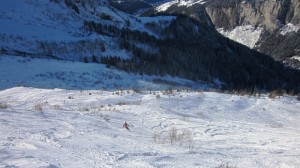
The trade-off for Avoriaz’s great location is ambiance. While its wood-clad exterior is certainly far easier on the eyes than some of the bleak concrete hotels that were thrown up in the very best high-altitude locations throughout the French Alps during the 1960s, I’ll always trade convenience for the cozy charm and intimacy of traditional mountain towns like Morzine and Les Gets.
For the final day of my trip, I went straight to the massive Swiss side of the Portes du Soleil, which encompasses six ski villages — some at altitude, others deep in the valley, but all facing south. This sector is thus great to visit during mid-winter, but I imagine that it’d get quickly torched by the sun during the latter part of the season. Whereas the French side is serviced predominantly by high-speed lifts and a wide array of on-mountain restaurants, the Swiss side offers a comparatively back-to-the-basics environment with mostly fixed-grip chairs or T-bars and fewer food and beverage options.
The Alps’ Secret Sauce
The Portes du Soleil distinguishes itself not only by vertical and breadth, but also by the variety of its terrain. With the exception of a high-altitude glacier, it has extensive offerings for most skill levels and preferences: piles of intermediate terrain, all sorts of above-the-treeline offpiste and hike-to goodies to challenge more adventurous skiers, and vast, deserted meadows and gullies that allow budding powder hounds to hone their skills.
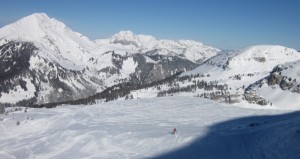
That said, the thing that makes these huge ski regions in the Alps truly unique for Americans is how a large percentage of skiers and riders rarely seem to leave the groomed trails. People from our side of the Atlantic can’t believe how comparatively untouched the off-piste terrain is only a few yards from the trails, even several days after the previous snowfall. One theory for this state of affairs is that skiing in Europe is a more informal activity than it is in the States. It appears to be practiced by many more lower-level participants who may go on only one destination vacation each winter (in which skiing is only part of the total experience) and tend to stay on piste.
Whatever the reason, U.S. powder hounds – especially those who frequent popular resorts like Snowbird, Alta, Jackson Hole, or Squaw Valley out west or Jay Peak and Stowe in the East, where local knowledge is often required to sniff out untracked stashes after a feeding frenzy – will shake their heads in astonishment at the ease of scoring untracked or lightly tracked snow. There’s rarely if ever a need for an in-depth planning session on the lift to figure out how to access the goods. Of course, the flip side of this desirable situation is that you need to be more of a defensive driver on groomed trails.
On-Mountain Cuisine
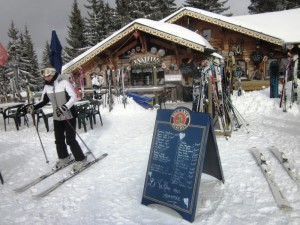
When in France, sooner or later you have to come to terms with the delicious food that we’ve all heard about – and I’m here to tell you that it’s all true. With a reported 90 (!) on-mountain establishments offering all sorts of French and Savoyard dishes, often prepared with local products, suffice it to say that the Portes du Soleil does not disappoint in the gastronomic department.
For Americans who often forgo a proper lunch in favor of fried something or other, pizza, or a power bar on a lift, it’s a real pleasure to go native – sit down in an atmospheric restaurant, relax, and enjoy yourself with top-notch food and drink. The cuisine is consistently so far above and beyond anything you get in the States (with the exception of Deer Valley-type places) that it’s unquestionably worth the financial hit.
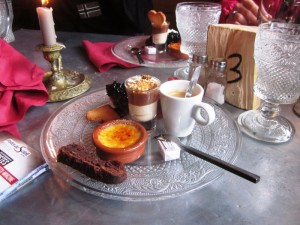
Another noteworthy observation is that unless they’re in the midst of a major snowstorm, people prefer to eat and drink outdoors and recline on lounge chairs in the sun. You’re on vacation, so act like it!
For More Information:
- Portes du Soleil
- Hôtel Alpina (Les Gets)
- Hôtel Équipe (Morzine)






The advantage of the Swiss side of the Portes du Soleil is you can actually get there by the superbly Swiss efficient train service. You can also get to a whole bunch of world class ski resorts from Basel and Zurich, both of which also have international airports. Zurich and Geneva also have railway stations right in the airport buildings. It is certainly feasible to fly in overnight and do a few turns before lunchtime at any number of fabulous ski resorts.
Agree about the amount of untracked off-piste you can easily get to in Europe. Not sure I agree with the analysis of why this is, but it is certainly (like the Swiss flag) a big plus!
I would love to stay on the Swiss side and take advantage of the easy rail connections from the airport. If only it weren’t so expensive being headquartered there.
My comment on why Euro off-piste seems to have less traffic than stateside was pure anecdotal speculation. 🙂